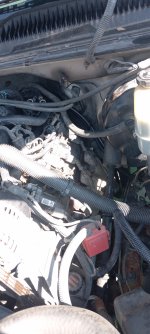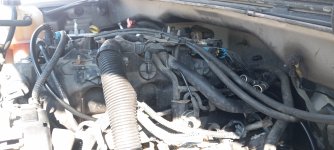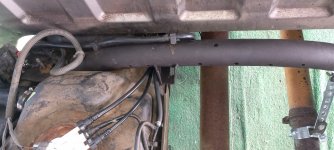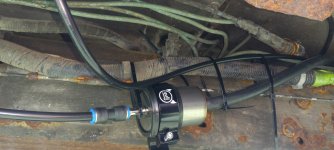Well at least the leak wasn't something we did wrong, a metal line nearthe canister rotted out, I guess all our bouncing things around was enough to finsh it off.
After that it was nightmare time, you can't get to anything in there, he checked out u-tube for some hints & basically you have to take half the truck apart to get to them, torsion bar, something in the 4 wheel drive over there, one guy dropped the tranny
Dorman and AGS sell a complete replacement kit, though it ain't cheap. It's designed to circumvent all the disassembly by including flex lines and junctions in certain spots. Our shop has done a few of these, and the high cost of the line kit is more than offset in saved labor. The lines route the same as the stock ones and take between 1-2 hours to install, pump to engine. New factory lines are just as, if not more, expensive than the Dorman kit if the former is even available, but the difference in labor is several hours.
If he hasn't already done it, the time's coming for brake lines. Dorman sells full prebent stainless-steel kits for $90-$200 (depending on truck) that replace every hard line on the truck, even the rear axle. They're a bargain, and the pain in the arse front-to-rear line can be slipped into place with the truck assembled. While it's not always the case, oft times that the fuel lines are disturbed, the brake lines get compromised in the process.
Me thinks these lines went in first & the darn truck was built around them!
They absolutely were. It's the most cost-effective way of doing it: easy installation, shorter (and hence cheaper) lines. Why on Earth would they do it any
other way? Read on....
I'd bet the chassis was completely built out then the cab and bed was installed.
This has been true of trucks since the dawn of the assembly line. When unitized construction came along, cars continued to use the "body drop" method.
I remember hearing about Ford trucks that required pulling the cab to work on things.
On several years of PowerStroke trucks, merely changing the injectors required pulling the cab. The guy who did pickups at the diesel shop could have the cab off in under 45 minutes, which is impressive when one considers brake lines, steering, etc. atop just pulling the bolts and unplugging wires. In several cases regarding areas at the rear of the engine, he'd pull the cab whether it was required or not just to ease access and shorten the job.
What folks don't understand is that in the automotive industry, the only design priority is getting each car assembled as quickly as possible. Labor is by far the automakers' largest expense. No thought is given toward service, and in fact the service manual isn't even written until well after the design is finalized (and the design team is not involved with its writing). The only concern is getting that car down and off the line as quickly as possible. There was literally never a time when manufacturers "built cars so you could work on them". Cars were just plain simpler 50+ years ago. Still, there are still decades-old instances where the "production first" mindset is obvious. The one that always comes to mind is the 1967 GM F-bodies. Most of the passenger's side front sheetmetal has to come off the car to replace the blower motor. After their 1970 redesign, this also included removing the bumper or header panel. Removing the dash structure on a Mopar A-body first requires pulling the windshield.
There are no stupid engineers. They do their jobs brilliantly, because their
job is to make the vehicle easy to assemble on a production line. Service is the dealer's (and eventually customer's) problem. It's one of the reasons I, perhaps foolishly, abandoned both my plan to work in the automotive industry and the engineering degree required to do so.
 Well that was just the start, to get it back on we had to remove the bumper & tow hitch again.
Well that was just the start, to get it back on we had to remove the bumper & tow hitch again.

 Me thinks these lines went in first & the darn truck was built around them!
Me thinks these lines went in first & the darn truck was built around them!



 The leftovers, the most expensive item was the fuel line, had to buy 25 ft lengths!
The leftovers, the most expensive item was the fuel line, had to buy 25 ft lengths! 
